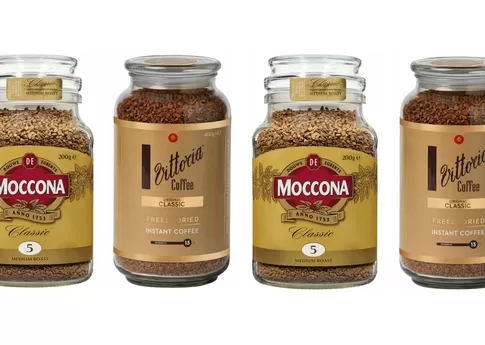Coffee Clash Victory: Vittoria Defeats Moccona in Landmark Jar Dispute
In a battle over branding and consumer loyalty, Vittoria Coffee has emerged victorious against the world’s largest coffee giant, Douwe Egberts, in a highly publicized Federal Court case in Australia.
The case, which centered around the design of Vittoria’s 400g Freeze Dried Instant Coffee jar, was brought by Douwe Egberts, owner of Moccona and other brands like Campos, L’Or, Harris, and Sacred Grounds.
The case sparked a price war with both brands selling the 400g jar of freeze dried coffee at half price at the supermarket. Freeze dried coffee isn’t everyone’s cup of tea but we drink a lot of it in our newsroom. The jars are collectibles items in many kitchens, with frugal households upcycling the jars into storage jars for other packaged kitchen goods, such as rice, powdered milk, even couscous and cooking salt.
Douwe Egberts alleged that Vittoria’s jar design misled consumers and infringed on their trademark, seeking to maintain a stronghold on the market segment. However, Justice Wheelahan dismissed all claims against Vittoria, siding with the family-owned Australian company.
In a press release, Vittoria expressed relief and gratitude over the outcome. “We are very happy with today’s judgment handed down by The Hon Justice Wheelahan in the Federal Court of Australia,” the statement read. “We were successful against the world’s largest coffee company.”
Vittoria’s win signifies a triumph for independent businesses, highlighting the challenges family-owned companies face when competing with international corporations in highly litigious arenas.
“This legal action cost our company a significant amount in legal fees, and very few family-owned coffee companies would have been able to afford such litigation,” the statement continued, emphasizing the resilience required to see the case through.
Vittoria argued that their jar design provided fair competition in the instant coffee market, a claim that resonated with consumers and the court alike.
“More competition can only mean better deals for Australian consumers,” Vittoria stated, underscoring the value of choice for buyers who’ve supported the brand for years in Australia’s cafes, restaurants, and five-star hotels.
CEO Les Schirato expressed his gratitude to thousands of Australian supporters who shared their loyalty to Vittoria online throughout the legal ordeal.
The win not only secures Vittoria’s unique market position but serves as a testament to their influence and dedication to the coffee sector. While Douwe Egberts hoped to stake exclusive claim to the 400g segment through legal action, Vittoria’s success guarantees a continued and competitive presence in Australian homes, enriching the coffee landscape for consumers.
Represented by a top-tier team of Tony Bannon, Ben Cameron, and Nicola Gollan, Vittoria now stands as a beacon for family-owned companies and their ability to triumph in disputes against global corporations.
The morning coffee ritual is a sacred act. For years, countless Australians and coffee lovers worldwide have reached for the familiar Moccona or Vittoria coffee jars on their kitchen shelves, each brand encased in its distinctive, robust glass jar.
The legal dispute stirred up the coffee industry, with Moccona suing Vittoria Coffee over one seemingly trivial but fiercely protected detail: the shape of their coffee jars.
The lawsuit, which has piqued both legal and consumer curiosity, revolved around the issue of “trade dress,” a specific form of intellectual property related to the look and feel of a product that makes it immediately identifiable in the marketplace.
Moccona argued that Vittoria’s latest jar design too closely resembled their own, confusing customers and infringing on their brand identity. For Moccona, whose branding rests heavily on the allure of its distinctive, sleek glass jar, this was no small matter.
The iconic jar has become synonymous with Moccona’s premium image and commitment to quality, and they claimed Vittoria’s design muddied that image, leading to “brand dilution.”
Vittoria, however, had a different story to tell. The brand argued that the jar shape was generic and functional, noting that coffee lovers are drawn more to the contents than to the container. Vittoria maintained that customers choose their coffee based on taste, origin, and quality, not necessarily by the shape of the jar.
They posited that their own jar design was a natural evolution in packaging, reflecting broader trends in consumer goods rather than a deliberate mimicry of Moccona’s design.
The legal arena for this battle was Australia’s Federal Court, where each brand marshaled teams of branding experts, designers, and market analysts to testify on their behalf. Moccona argued that the jar’s specific dimensions, curves, and even its cap were deliberately chosen to project a certain “premium” perception, which Vittoria’s design allegedly copied.
Vittoria’s defense countered that there are only so many ways to design a glass jar while maintaining functionality and market appeal, and that their design differed in subtle but significant ways.
As the trial unfolded, it revealed the competitive intensity in the coffee market, where each brand works relentlessly to distinguish itself in a saturated landscape. Brand loyalty among coffee drinkers is strong, but in a world where grocery aisles are crowded with choices, packaging remains a vital part of each brand’s appeal. The dispute even shed light on how design choices, down to the curve of a jar, are meticulously crafted to influence consumers.
The case of Moccona versus Vittoria has underscored the power of packaging in today’s marketplace, where visual identity is as fiercely protected as flavor. This wasn’t just a case about coffee jars; it was a reminder that even in a product as simple as instant coffee, every detail counts. Brands are not only fighting for shelf space but also the right to be uniquely themselves, one sip at a time.
Related stories
Kitchen knives ° Anthony Bourdain’s Kramer Knife
Vegetarian Book Review: The Yearlong Pantry by Erin Alderson
The Art of Sauces for Steak: 4 Classic Steak Sauce Recipes
Advertisement:




